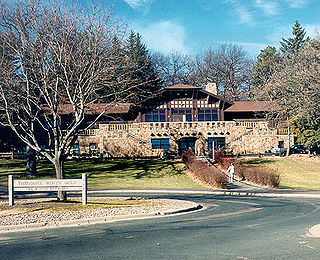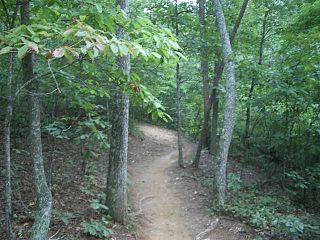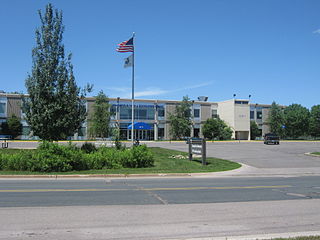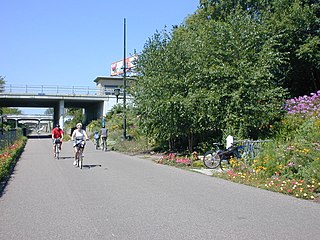
A trail, also known as a path or track, is an unpaved lane or a small paved road not intended for usage by motorized vehicles, usually passing through a natural area. In the United Kingdom and Ireland, a path or footpath is the preferred term for a pedestrian or hiking trail. The term is also applied in North America to accompanying routes along rivers, and sometimes to highways. In the US, the term was historically used for a route into or through wild territory used by explorers and migrants. In the United States, "trace" is a synonym for trail, as in Natchez Trace.

Mountain biking is a sport of riding bicycles off-road, often over rough terrain, usually using specially designed mountain bikes. Mountain bikes share similarities with other bikes but incorporate features designed to enhance durability and performance in rough terrain, such as air or coil-sprung shocks used as suspension, larger and wider wheels and tires, stronger frame materials, and mechanically or hydraulically actuated disc brakes. Mountain biking can generally be broken down into distinct categories: cross country, trail, all mountain, enduro, downhill and freeride.

Kona Bikes is a bicycle company based in the Pacific Northwest. The company was founded in 1988 by Dan Gerhard, Jacob Heilbron and Jimbo Holmstrom in Vancouver, BC. Their world headquarters are in Ferndale, Washington, with Canadian distribution offices in Vancouver, and European distribution offices in Monaco.

The Grand Rounds National Scenic Byway is a linked series of park areas in Minneapolis, Minnesota, United States, that takes a roughly circular path through the city. The Minneapolis Park and Recreation Board developed the system over many years. The corridors include roads for automobile traffic plus separate paths for pedestrians and bicycles, and extend slightly into neighboring cities. About 50 miles (80 km) of roadway and paths are in the system, and much of it was built in the 1930s as part of Civilian Conservation Corps projects.

Theodore Wirth Park is the regional park managed by the Minneapolis Park and Recreation Board. The park land is shared by Minneapolis and the neighboring suburb of Golden Valley. Formally named Theodore Wirth Regional Park, it includes two golf courses, Wirth Lake, Birch Pond, cross-country ski trails, mountain biking trails, snow tubing hills, and other amenities. It forms a significant portion of the Grand Rounds Scenic Byway, linking the Chain of Lakes area with the Victory Memorial Parkway.

The International Mountain Bicycling Association-Southern Off-Road Bicycle Association (IMBA-SORBA) is an advocacy organization for mountain biking in the Southeastern United States. IMBA-SORBA is a regional division of International Mountain Bicycling Association, managed by an executive director and a board of directors. The board of directors is composed of an elected executive board, plus one representative from each chapter. The organization has over 5000 members.

Three Rivers Park District is a special park district serving the suburban areas of the Twin Cities including suburban Hennepin, Carver, Dakota, Scott, and Ramsey counties. Three Rivers's mission is "To promote environmental stewardship through recreation and education in a natural resources-based park system." Three Rivers operates twenty parks and ten regional trails, with at least two more regional trails planned. Nearly seven million people visit Three Rivers facilities each year. It has over 27,000 acres (11,000 ha) of parks and trails.

Cuyuna Country State Recreation Area (CCSRA) is a state park unit of Minnesota, USA, being developed to rehabilitate a portion of the Cuyuna Range where mining pits and piles of waste rock were left behind after decades of open-pit mining for iron ore. Abandoned by mining companies more than 20 years ago, the state recreation area consists of regenerated vegetation and clear lakes that draw a wide range of recreation enthusiasts. The park is located off Minnesota State Highway 210, near the towns of Crosby, Ironton and Cuyuna. The Croft Mine Historical Park, formerly city-run, is now part of the state recreation area.

The International Mountain Bicycling Association (IMBA) is a non-profit educational association whose stated mission is to create and preserve trails for mountain bikers worldwide.
Alafia River State Park is a Florida State Park, located near Picnic in Hillsborough County in central Florida, 17 miles southeast of Tampa on County Road 39. Even before it became a park, the area, and particularly Hurrah Lake, was the center of leisure activities since the early 1880s.

Singletrack describes a type of mountain biking trail that is approximately the width of the bike. It contrasts with double-track or fire road which is wide enough for four-wheeled off-road vehicles. It is often smooth and flowing, but may also feature technical rocky sections, go over tree roots, and include berms, banked turns, switch-backs, hills, drops, jumps, and so forth. Singletrack which descends significantly, and in the most downward direction, is said to be following the fall line.

Dalby Forest is a forest located on the southern slopes of the North York Moors National Park in North Yorkshire, England. It is maintained by Forestry England. Dalby Forest, along with Langdale Forest and Cropton Forest, forms part of the North Riding Forest Park, found within the North York Moors National Park.

Cycling in Minnesota is a popular form of recreation, commuting, and competitive sport that has grown in prominence over the years. It has been a popular activity in the state since the late 19th century.
Womble Trail, located in the Ouachita National Forest in western Arkansas, United States, is a singletrack path running more than 37 miles from North Fork Lake to the Ouachita National Recreation Trail. The U.S. Forest Service trail is open for use by mountain bikers and hikers. Horses are not allowed. The nearest towns are Mount Ida and Oden.

Mountain biking in Australia is a mix of dedicated mountain bike parks, ski resorts with mountain bike facilities, and other parks that have become popular with mountain bikers despite lacking dedicated facilities. The peak body for the sport is Mountain Bike Australia (MTBA).

The Minneapolis Park and Recreation Board (MPRB) is an independent park district that owns, maintains, and programs activities in public parks in Minneapolis, Minnesota, United States. It has 500 full-time and 1,300 part-time employees and an $111 million operating and capital budget.

Minneapolis is often considered one of the top biking and walking cities in the United States due to its vast network of trails and dedicated pedestrian areas. In 2020, Walk Score rated Minneapolis as 13th highest among cities over 200,000 people. Some bicycling ratings list Minneapolis at the top of all United States cities, while others list Minneapolis in the top ten. There are over 80 miles (130 km) of paved, protected pathways in Minneapolis for use as transportation and recreation. The city's Grand Rounds National Scenic Byway parkway system accounts for the vast majority of the city's shared-use paths at approximately 50 miles (80 km) of dedicated biking and walking areas. By 2008, other city, county, and park board areas accounted for approximately 30 miles (48 km) of additional trails, for a city-wide total of approximately 80 miles (130 km) of protected pathways. The network of shared biking and walking paths continued to grow into the late 2010s with the additions of the Hiawatha LRT Trail gap remediation, Min Hi Line pilot projects, and Samatar Crossing. The city also features several natural-surface hiking trails, mountain-biking paths, groomed cross-country ski trails in winter, and other pedestrian walkways.

Luce Line Trail is a 74.9-mile (120.5 km), shared-use path in Minnesota, United States, that stretches from Cosmos to Minneapolis. The trail system was built after 1995 when the Luce Line Railroad was abandoned west of Interstate 494. The previous line extended 104 miles (167 km) to Gluek. The multi-use trail has varying surface features, though it is primarily made up of crushed limestone or aggregate base, and the section from Cosmos to Cedar Mills is undeveloped, as are the sections from just west of Hutchinson to Winsted and east of Plymouth. The trail is maintained by the Minnesota Department of Natural Resources west of Vicksburg Lane, where it is named Luce Line State Trail. East of Vicksburg Lane, it is maintained by the Three Rivers Park District and named Luce Line Regional Trail.

Mississippi Gorge Regional Park is a regional park along the east and west bluffs of the Mississippi River in the cities of Minneapolis and Saint Paul in the U.S. state of Minnesota. The two-city park area is between Mississippi river miles 848 and 852, from just south of Northern Pacific Bridge Number 9 to just north of Minnehaha Regional Park, and lies within the Mississippi National River and Recreation Area. The park area protects scenic and natural areas of the Mississippi River gorge, the only true gorge along the entire length of the 2,320-mile (3,730 km) river.

Cycling in Canberra, the capital city of Australia, is a popular means of transportation, sporting and recreational pass time. Commuting in the city is supported by an extensive network of urban cycleways and on-street bicycle lanes. As a city established in the 20th century, Canberra's development was heavily influenced by the automobile for much of its history. The popularity of cycling in the city has increased dramatically in the 21st century with growing awareness of environmental issues, government policy supporting active transport and investment in cycling infrastructure. This has led to the development of a strong cycling culture.


















